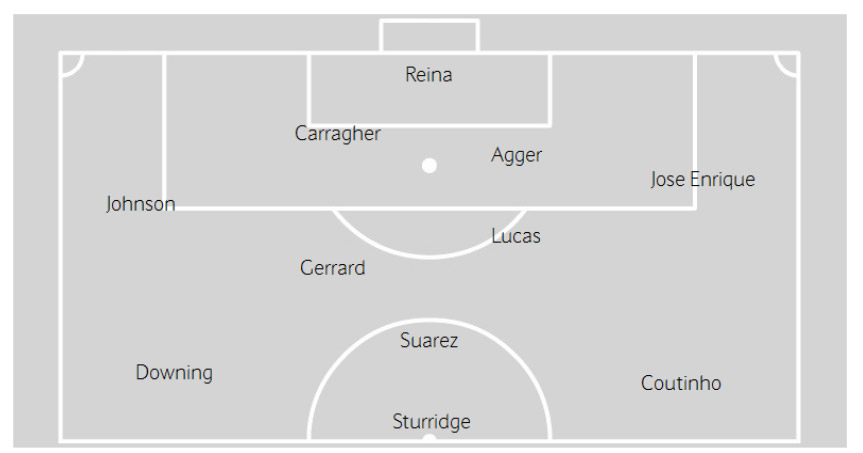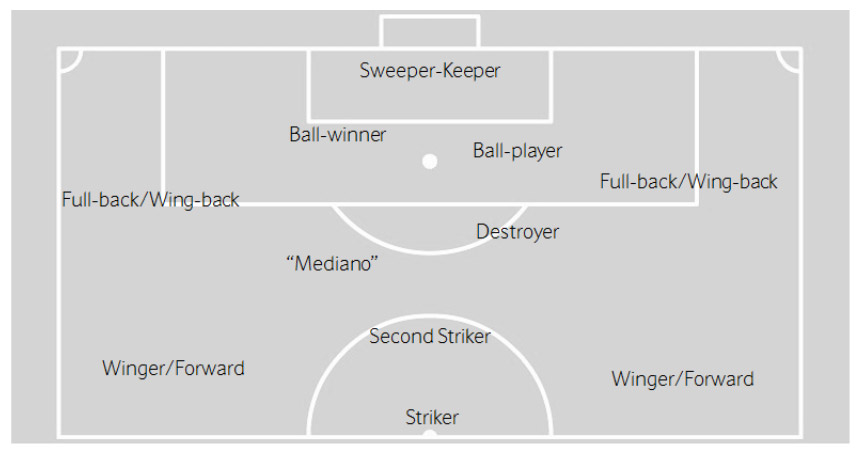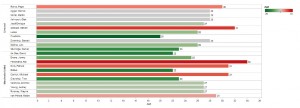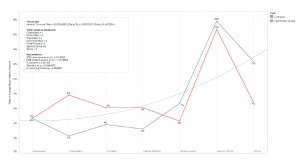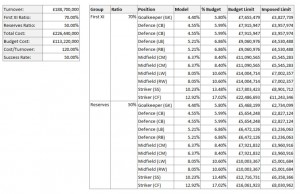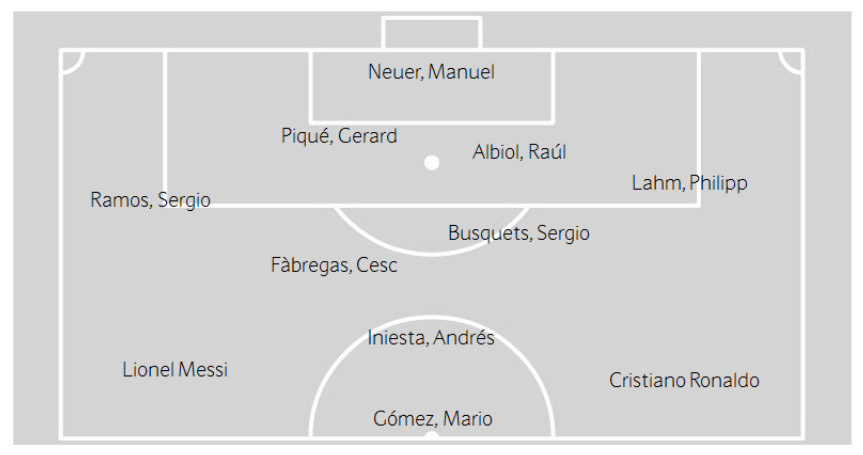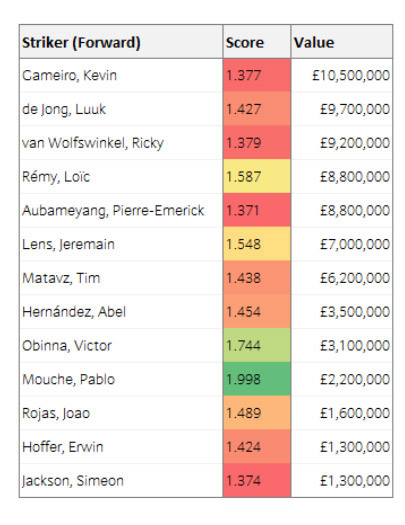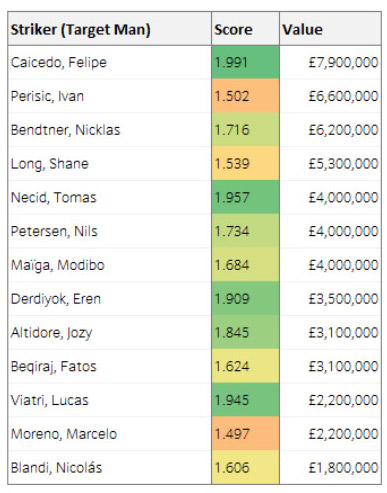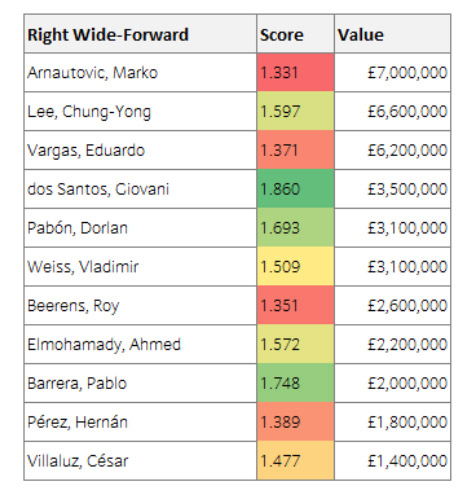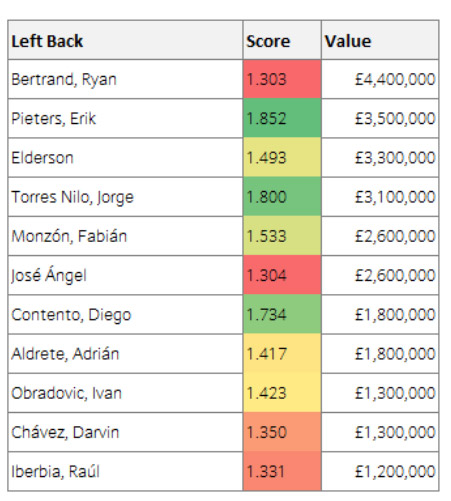By TTT Subscriber and professional Data Analyst Lee Mooney.
This article was originally published on Monday for Subscribers only, with the intention to make it a free read next week. However, interest in the piece has been such that we’ve brought it forward to today. As with all TTT articles, the excellent debate below the article remains for Subscribers only.
I left the Swansea game at Anfield a couple of weeks ago feeling inspired. Not because we’d won the game, though that was brilliant, but because I feel I got a glimpse of the future under Brendan Rodgers. The balance of the side was great and the gaps seemed clearer than ever. As is often the case, rather than argue in a pub like a normal person, I turned to the data. In this article I’ve used analysis to identify key areas of the field that need to be invested in. I’ve also offered detailed rationale as to how much should be invested and suggested likely candidates for each of the key roles.
Inspired by the recent game against Swansea at Anfield
The Liverpool side that faced Swansea last week looked like this:
It is my opinion that the Liverpool squad is being re-configured to fit the following tactical frame (some of the roles and descriptions used here are described more fully in the zonalmarking.net glossary):
Despite playing a weakened opponent, the side against Swansea seemed balanced and equally ‘able’ across all areas of the field (perhaps with the exception of Downing who didn’t appear to fit well with the movement of Suarez, Coutinho or Sturridge). The team on Sunday also seemed to be the closest yet to having the right quality of player in the right role.
So, for Liverpool to move forward, which areas of the field should be invested in, how much should be invested and who should be bought?
How much money should Liverpool FC spend on players?
One of the things that I’ve found particularly frustrating recently has been the talk about transfers. Fan expectations around the fees that should be paid seem to have no relation to the club’s financial position. What follows is a very simplistic attempt to understand how a squad budget might be broken down. Hopefully those who specialise in the club’s finances will provide deeper insights than I will here. What I’m positioning is really just a starter to encourage debate, discussion and further refinement.
I know it’s delicate to use Manchester United as a benchmark for any analysis. But, given the sheer volume of winning they’ve done in the last 20 years, it seems reasonable to assume that they know a thing or two about assembling a squad.
For this exercise I’ve used the squad values for Liverpool and Manchester United, as recorded on transfermarkt.co.uk, along with the 2012 revenue figures published by Deloitte as part of the 2013 Football Money League.
I appreciate these transfer valuations alone will be hugely open to debate, but if the base of data is consistent for both clubs then we should arrive ‘close enough’ to the desired end-point. The distinction between ‘starting XI’ and reserves has been made based on appearances this season. The diagram below shows my suggested starting XI for both clubs (again, I recognise the simplicity here and that tactical variation is required):
Taking these two starting XI lists, I’ve produced the graphic below which shows the ratio of average player value to club turnover, by club and the generic playing position:
If I was the Liverpool FC Director of Football (no protests please), I would be obsessed with reconciling a number of potentially conflicting key concepts:
- Budget: how much should I be spending to staff a particular first XI or reserve role?
- Cost: how much has/will it cost to recruit and retain a player?
- Value: how much is a player worth in the transfer market today?
- Value Forecast: how much is a player likely to be worth in the transfer market in the future?
- Benchmark: what level of consistent performance does the team require?
- Capability: what level of consistent performance does the player offer to the team today?
- Potential: what level of consistent performance is a player likely to offer the team in the future?
- Shelf-life: how many more games can the player consistently sustain the required performance level?
- Capacity: how many match-play minutes can a player sustain to maximise their total return?
- Utilisation: how many match-play minutes is a player being used?
I would also operate under two bold guiding principles:
- The right player is always available at the right price and at the right time – the challenge is finding them
- Always walk away from a deal that doesn’t meet the club’s expectations of quality and value
Looking at the current squad through this lens, the ‘shelf-life’ concept would have me thinking very carefully about any player that is 28 years old (or older). Being older doesn’t always mean a player lacks ‘capability’, but it may limit their ‘capacity’ to perform consistently at the required performance level. With the market value of an outfield player deteriorating so rapidly beyond the age of 29, reaching the age of 28 is a key opportunity to ask some difficult questions:
- Is the on-field value the player has left to offer less than their current market value?
- Is the player operating consistently at the required level and how likely is this to continue?
- In real terms, is the player worth more today than the club originally paid for them?
- Can I replace this player with somebody younger and/or cheaper and re-invest my budget in another area?
- Do we have first-team ready replacements for these players in the current squad?
With the exception of Pepe Reina (because goalkeepers have a longer shelf-life than out-fielders – though perhaps the recent TTT Symposium is suggesting otherwise) I’d be asking these questions in-relation to the following players:
- Steven Gerrard;
- Daniel Agger;
- Martin Skrtel;
- Glen Johnson; and
- Stewart Downing
Looking at the difference between Manchester United and Liverpool on the chart, the following observations also jumped out to me:
- Squad values, when seen in the context of club turnover, are largely comparable
- The depreciation of Ferdinand, and the absence of Vidic, deflates Manchester United’s centre-back ratio
- The gap between ‘strikers’, especially when you consider the cover Manchester United have, is ‘striking’
- The gap between ‘wide forwards’ is worth further investigation
The money ‘league table’ produced by Deloitte also suggests that Liverpool, at least in revenue terms, should be strong enough to achieve 5th in the Premier League. Given the near-fatal management of recent years it seems, at least to me, grossly unfair for anyone to expect Liverpool to reach that level this season. It also suggests that Liverpool fans have no ‘right’ to expect regular participation in the Champions League, only that Liverpool should be generally competing for a qualification place.
So, how much should Liverpool FC spend on players? To estimate this theoretically we need to consider two more variables:
- the probability that the transfer will be a ‘success’; and
- a limit for the value of the squad based on club turnover (budget)
To populate these variables I need to refer to the 50/50 ‘rule of thumb’ from ‘Pay as You Play’ around transfer success. The basic suggestion being that a good manager gets as many deals right as they do wrong. To me this means, at least in theory, that a manager’s track-record should directly affect their budget.
I’ve based the budgets for the first XI and reserve XI on the squads of Manchester United and Liverpool (both show approximately 70% of turnover is allocated to the starting XI and 50% of turnover to the reserve XI – so overall it seems we’re looking at a hard ceiling of 120% of turnover). Notice we’re talking about value, not cost.
[PT looked at the “worth” of the squad here, with TTT’s village elders suggesting what they thought each player was now worth, and with an average figure of £289m for the entire squad, although some younger players have values higher than what they are currently capable of delivering, given that they were priced with potential in mind.]
So, in an ideal world, the value of the squad in real-terms would be higher than the cost of building it. The Academy could really be seen as a ‘value factory’ where value is made rather than bought.
What I found interesting from this simple modelling is the suggested budgets for each first XI role. It seems we’re operating around the ‘Imposed Limit’ level for the more recent signings. Could this be the effect of recent hires that weren’t available prior to the January window? Obviously ‘value for money’ is a key element that needs to be kept at the top of the agenda – those charged with spending the club’s money need to be doing so with ruthless efficiency – getting as much value as possible within these guiding limits.
Which areas of the field should Liverpool FC invest in?
The key gaps between the Liverpool and Manchester United squads seem to be in the ‘striker’ and ‘wide forward’ roles. The recent acquisition of Coutinho appears to be an attempt to reinforce in this area. With Henderson and Allen both operating effectively at first-team level it would appear the most pressing priorities are to reinforce:
- the first-team striking options;
- the right-sided wide-forward position (currently occupied by Stewart Downing); and
- the left-back position.
There are several options for meeting these short-term objectives, my personal preference would be to:
- recruit a first-team ready player who will be effective as a striker (and ideally as a second striker);
- redeploy Glen Johnson as a wide-forward and promote a youth player to the first-team at right-back;
- sell Stewart Downing to release investment funds; and
- recruit a player that can provide cover for Jose Enrique and be ready to replace him in the next 2 years.
Which players should Liverpool buy?
Player recruitment has certainly become my specialist area. I see no other aspect of the football business where relatively small data and analysis investments have the potential to deliver a big commercial impact (which, hopefully, translates into on-field growth and success on the pitch).
To make these recommendations I’ll be using the same version of my recruitment model which I used recently, with some controversy, to compare Liverpool and Manchester United. This time though, I’ll provide more detail as to how the model works (and where it doesn’t).
This first version of my model is limited. This is mostly due to the data that I’ve been able to collect within a time-frame that’s relevant. For example, I could collect better data, but the process is so slow that getting to market with useful information is impossible. When time is critical, you either throw money at the problem (which I don’t have) or you compromise quality. Keep in mind, ‘good-enough’ might be all we need. So, players are rated based on the squad value of the club they play for today, not who they’ve played for before and not based on what any of those clubs have actually achieved in terms of league places. Similarly, domestic appearances are also not counted – so a squad player who never plays for Barcelona scores the same a player who plays all the time. Addressing these two weaknesses is a priority for version 2.
The basic components of this version of the model are as follows:
- National Team Score: indicating the strength of the player’s national team
- Base Country Score: indicating the strength of the player’s domestic nation (where their club plays)
- Club Score: indicating the value of a squad compared with that of the top club side (Barcelona)
- Weighted International Apps: measure of appearances based on the strength of the nation
- Weighted International Apps Score: measure accounting for player’s age and playing position
Four of these elements are then combined to create a Player Score using the following formula:
(Base Country Score x Club Score) + (National Team Score) + (Weighted International Apps Score)
The relative simplicity of these calculations, perhaps with the exception of the ‘Weighted International Apps Score’ which required a fair bit of engineering and testing, makes it possible to apply them consistently across a large dataset (in this case a reference catalogue of over 92,000 players).
Having a domestic and international perspective is also powerful. Using both perspectives helps to identify talents that have perhaps been overlooked. If a player is making regular full international appearances at 19 for a strong footballing nation, they’re possibly worth looking at a little more deeply, even if they do play for a club you haven’t heard of.
I was asked specifically about the scoring of Jamie Carragher compared with Nemanja Vidic. There are 1,208 central defenders in the model aged over 33. Carragher is ranked 15th (playing in England, only Rio Ferdinand ranks more highly – with the top of the list occupied by Carles Puyol). Very few of the top clubs in world football have central defenders still playing that are over the age of 33. This doesn’t mean that Carragher is ‘better’ than Vidic, but he is quite extraordinary to be doing what he’s doing at 34 (hence the high score).
Before drilling into specifics about Liverpool FC, I thought it might be useful to show a ‘dream team’ that was picked solely by using this model and one filter – that the player must be under the age of 29. Here it is:
What do you think? Without any human intervention at all a simple set of data has been used to create a ‘dream team’ that would generally ‘make sense’ to most football fans with a basic knowledge of European football. Can we be more specific now and make suggestions about the current Liverpool squad – safe in the knowledge that the model isn’t complete nonsense?
I concluded earlier in the piece that Liverpool should look to prioritise three specific on-field positions (from a recruitment perspective):
- first XI striker (budget up to £11.3m);
- first XI right-sided wide-forward (budget up to £7.0m); and
- first XI left-back (budget up to £4.5m).
Identifying candidates for these roles requires some final filters to be applied (along with the financials):
- define the target age-range
- define the minimum score a potential Liverpool player should have
The ideal target age-range would appear to 22 to 25 (my rationale for this won’t win a Nobel Prize anytime soon). The work I did on strikers last year suggested a peak age-range of 26 to 29. The value of a younger purchase will have time to grow, so fees stand a chance of being recovered and re-invested.
The lowest scoring Liverpool player in the model (remember the model data is over six months old now), is Jordan Henderson. Henderson scores 1.393 so to simplify we’ll say that recruiting for the Liverpool FC first XI should not consider players with a score less than 1.300.
The first XI striker position (budget up to £11.3m)
So, having applied the filters and referenced www.transfermarkt.co.uk to gauge market values, the short-list of potential targets is quite interesting. The most surprising result was that Daniel Sturridge (valued at £13m) meets all of these conditions and has the highest value within reasonable reach for the ‘Striker (Forward)’ category (players like Lewandowski and Cavani obviously score very well, but they are way beyond the budget we’ve set here). Full results below (only includes players valued at £1m or above to make the results readable):
The first XI right-sided wide-forward position (budget up to £7.0m)
Objectivity can be a real pain! A couple of players score highly on this list but need to be excluded because of their estimated market value – players like Martin Harnik, Jose Callejón and Kevin Mirallas for example. Alas, when the rules are applied the list is as follows:
The first XI left-back position (budget up to £4.5m)
Not a great list of candidates are available that meet both the conditions of value and quality (it would appear). Do any of these players stand out for you?
Conclusion
The recruitment model I’m developing is in the very early stages. There will be considerable variance in terms of the quality of recommendations. With time and investment though, this variance will be removed and the robustness of the model will grow. That said, even at this early stage, the analysis results when using this model produce some interesting insights. At worst it prompts thinking about players you’ll most-likely never have heard of (which in itself has to be a good thing). Some of its suggestions may be unobtainable due to price or because they are already at a rival club who won’t do business with Liverpool, but they can easily be ignored.
During the review Paul specifically asked me about Coutinho, and whether he would have shown up as a recommendation.
Coutinho is a left-sided attacking midfielder who’s in the 16 to 21 age range. There are nine players within this segment that could potentially ‘cut the mustard’ for LFC. These are:
– Mario Gotze (£37.0m)
– Eden Hazard (£35.0m)
– Lucas Moura (£31.0m)
– Erik Lamela (£19.5m)
– Coutinho (£8.8m)
– Adem Ljajic (£5.7m)
– Tommy Oar (£875k)
– Yohandry Orozco (£450k)
– Gai Assulin (£450k)
Once you apply the budgetary constraints, and perhaps consider that some of these players might already be getting Champions League football, you’re left with five players to consider (three of which would really be considered ‘gambles’). So, using this model alone, if you’d have asked me a couple of months ago to find an attacking left-sided midfielder under the age of 21 within Liverpool’s budget, I’d have recommended Coutinho or Adem Ljajic.
When Damien Comolli arrived I made a bold suggestion that he might not be as good as he was hyped up to be. The exact recruitment decisions that were made could have been prompted by simply analysing the prior year’s fantasy football data alone (which emphasises assists, goals and a clean disciplinary record). The fees that were paid also seemed to be based on a crude average (an average that included the astronomical fees being paid by clubs like Manchester City and Chelsea – effectively doubling what we were spending compared with our comparable rivals).
The current regime does not appear to be operating in this way. With the exception of the deal to buy Joe Allen (whose £15m fee is way above the hard ceiling of £11m I’d permit and three times the budget limit of £5m) the transfers so far seem to be far more aware of the ‘key concepts’ outlined here than Comolli ever was – at Liverpool, at least. This has to be a good thing for the club moving forward.
